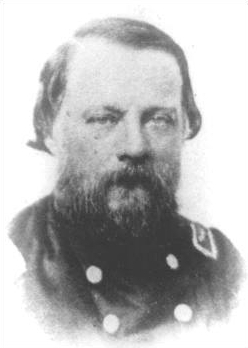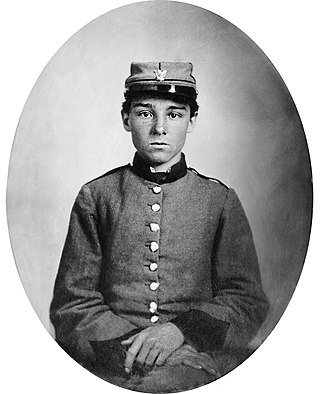
The 71st Regiment, Pennsylvania Volunteer Infantry was an infantry regiment of the Union Army that participated in the American Civil War.

The 11th Pennsylvania Infantry Regiment was a Union army regiment that participated in the American Civil War. It had the distinction of being the oldest unit in continuous service from Pennsylvania.
The 139th Pennsylvania was an infantry regiment in the Union Army during the American Civil War.

The 23rd Pennsylvania Volunteer Infantry was an infantry regiment that fought in the Union Army during the American Civil War. Known for its colorful uniforms based upon the popular French Zouave style, the regiment served in the Eastern Theater.
The Philadelphia Brigade was a Union Army brigade that served in the American Civil War. It was raised primarily in the city of Philadelphia, Pennsylvania, with the exception of the 106th regiment which contained men from Lycoming and Bradford counties.
The 106th Pennsylvania was a volunteer infantry regiment which served in the Union Army during the American Civil War. It was part of the famous Philadelphia Brigade, which helped defend against Pickett's Charge in the Battle of Gettysburg.
The 116th Pennsylvania Infantry was a volunteer infantry regiment in the Union Army during the American Civil War. It formed a part of the Irish Brigade.
The 54th Pennsylvania Volunteer Infantry was an infantry regiment which served in the Union Army during the American Civil War.

The 90th Regiment, Pennsylvania Volunteer Infantry was a volunteer infantry regiment which served in the Union Army during the American Civil War. They wore chasseur-style uniforms, which each consisted of a dark blue habit veste with white trim, baggy sky-blue trousers and a dark blue kepi. The buttons on the habit veste were unique to the 90th Pennsylvania. They were the only Union regiment in the entire war to have a specific button design.

The 3rd Pennsylvania Heavy Artillery was a heavy artillery regiment that fought in the Union Army during the American Civil War.

The 53rd Pennsylvania Volunteer Infantry was a volunteer infantry regiment in the Union Army during the American Civil War.
The 140th Regiment Pennsylvania Volunteer Infantry was a Union Army regiment in the American Civil War, serving in the Eastern Theater. Recruited in late 1862, it fought from the Battle of Chancellorsville through the war until the Army of Northern Virginia's surrender at Appomattox Court House. Its losses during the war were among the highest of any Union regiment.

The 125th New York Infantry Regiment was a volunteer regiment from Rensselaer County, New York, during the American Civil War. Formed during the summer of 1862, the unit was officially mustered into United States Service on 27–29 August 1862, by Col. George L. Willard. He had seen previous service in the Mexican War as well. Levin Crandall was commissioned lieutenant colonel, and James C. Bush major. The unit was mustered out on 5 June 1865.

The 64th New York Infantry Regiment, the "First Cattaraugus Regiment", was an infantry regiment of the Union Army during the American Civil War.

The 199th Regiment Pennsylvania Volunteer Infantry, alternately known as the Commercial Regiment, was an infantry regiment of the Union Army in the American Civil War. Raised in Philadelphia in late 1864, the regiment enlisted for one year and was sent to the Army of the James during the Siege of Petersburg. During the Third Battle of Petersburg it assaulted Forts Gregg and Alexander, then pursued the retreating Confederate Army of Northern Virginia, fighting at Rice's Station and Appomattox Court House. Following the Confederate surrender at Appomattox, the regiment moved to Richmond, where it mustered out in late June 1865.

The 1st Louisiana Infantry Regiment was a unit of volunteers recruited in Louisiana that fought in the Confederate States Army during the American Civil War. Formed in April 1861, the regiment was sent to fight in the Eastern Theater of the American Civil War. Joining a brigade of Louisiana regiments, it fought at Malvern Hill, Second Bull Run, Antietam, and Fredericksburg in 1862, at Chancellorsville, Second Winchester, Gettysburg, and Mine Run in 1863, and at the Wilderness, Spotsylvania, Monocacy, Third Winchester, Fisher's Hill, Cedar Creek, and Petersburg in 1864, and at Appomattox in 1865. At Appomattox, the regiment was only a shadow of its former self.

The 2nd Louisiana Infantry Regiment was a unit of volunteers recruited in Louisiana that fought in the Confederate States Army during the American Civil War. Formed in May 1861, the regiment was sent to fight in the Eastern Theater of the American Civil War. Its first action took place during the Siege of Yorktown. The regiment suffered very heavy losses at Malvern Hill. After joining an all-Louisiana brigade, it fought at Cedar Mountain, Second Bull Run, Antietam, and Fredericksburg in 1862, at Chancellorsville, Second Winchester, Gettysburg, and Mine Run in 1863, and at the Wilderness, Spotsylvania, Cold Harbor, Monocacy, Third Winchester, Fisher's Hill, Cedar Creek, and Petersburg in 1864, and at Appomattox in 1865. The regiment lost over 100 men at both Second Bull Run and Chancellorsville. A company-sized remnant surrendered at Appomattox.

The 8th Louisiana Infantry Regiment was a unit of volunteers recruited in Louisiana that fought in the Confederate States Army during the American Civil War. Formed in June 1861, the regiment was sent to fight in the Eastern Theater of the American Civil War. Joining a brigade of Louisiana regiments, it fought in Jackson's Valley campaign and at Gaines' Mill, Malvern Hill, Second Bull Run, Antietam, and Fredericksburg in 1862. The regiment served at Chancellorsville, Second Winchester, Gettysburg in 1863. At Rappahannock Station in November 1863, most of the regiment was captured. The unit fought at the Wilderness, Spotsylvania, Cold Harbor, and the Valley campaigns of 1864. It served at Petersburg starting in December 1864 and surrendered at Appomattox in April 1865.

The 7th Louisiana Infantry Regiment was a unit of volunteers recruited in Louisiana that fought in the Confederate States Army during the American Civil War. Formed in June 1861, the regiment was sent to fight in the Eastern Theater of the American Civil War. After fighting at First Bull Run, the unit joined the 1st Louisiana Brigade. The regiment served in Jackson's Valley campaign and at Gaines' Mill, Malvern Hill, Cedar Mountain, Second Bull Run, Harpers Ferry, Antietam, and Fredericksburg in 1862. The regiment fought at Chancellorsville, Second Winchester, and Gettysburg in 1863. At Rappahannock Station in November 1863, almost the entire regiment was captured. The remnant of the unit fought at the Wilderness, Spotsylvania, Cold Harbor, and the Valley campaigns of 1864. It served at Petersburg starting in December 1864 and surrendered at Appomattox in April 1865.
The 13th Mississippi Infantry Regiment was a unit of the Confederate States Army from Mississippi. As part of the Army of Northern Virginia, the 13th Mississippi took part in many battles of the Eastern theater of the American Civil War, as well as some battles in Georgia and Tennessee. The 13th Mississippi Regiment surrendered at Appomattox Court House on April 9, 1865.










